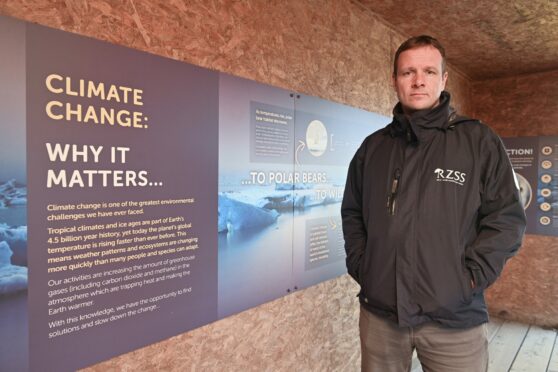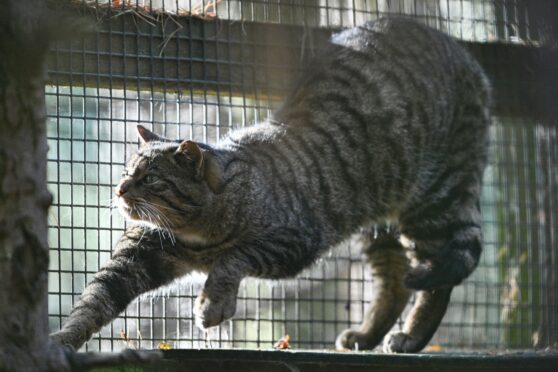Nature recovery must be at the “heart” of COP26 discussions in order to address the “twin” biodiversity and climate crises.
That’s according to Ben Supple from the Royal Zoological Society of Scotland (RZSS).
Ben Supple is the charity’s director of engagement and business development.
The RZSS works to protect species including iconic polar bears – long linked in the public’s mind with the heart-breaking effects of climate change.
But also giant armadillos in Brazil. Then closer to home with endangered pine hoverfly in Cairngorms National Park. And many more besides the Aviemore polar bears.
Why Aviemore polar bears became ‘ambassadors’ for the climate crisis
He said animals like the polar bears in the park are a “flagship” species. Many other creatures, however, also face a hard future.
The Aviemore park is home to polar bear Victoria. She is the only female polar bear in Scotland. And two males Arktos and Walker. Then Hamish, who is the first polar bear cub to be born in the UK for 25 years.
He said: “Their habitat is hugely affected. They’ve long been the ambassador, the flagship in many ways, to highlight the exceptionally damaging impact and effects of climate change on species all over the world.
“Polar bear’s natural habitat, sea ice, is shrinking drastically due to climate change. This means the areas they live and hunt in are shrinking.
“The projections are the polar bear population will decline by as much as 30%, or maybe more, over the next 30 to 40 years. That is absolutely tragic and alarming.”
The RZSS runs the Highland Wildlife Park in Aviemore. The charity also operates Edinburgh zoo.
How Brazil and Scotland are united to protect at risk species
Ben continues. “Climate change is the crisis of our age.
He suggested the problem is much wider than the one symbolised by the Aviemore polar bears.
“Obviously in human terms in terms of access to shelter, water, food, and prosperity. But also for nature. Because there is a twin crisis: the climate crisis, and the biodiversity crisis.
“The RZSS works across the world with a variety of different partners.
“A good example of the impact of climate change would be our work in Brazil. We work with expert partners on the conservation and protection of magnificent species such as the ant-eater and the giant armadillo.
“We’re getting increasingly used to, unfortunately, seeing extreme weather and extreme events. The area in which our partners work in Brazil is the Brazilian Pantanal. It is the largest wetland in the world.
“Unfortunately, last year was the biggest drought that wetland has experienced in 50 years. This year is predicted to be the biggest drought in more than a century.
“That wetland was absolutely devastated last year by the most horrendous fires. They did horrendous damage to the ecosystem there and the species that we are seeking to protect.”
‘More than a million species’ at risk of extinction worldwide
“So it’s exceptionally important, whether it’s here in Scotland, or around the world, that we are all taking the action which is required to combat climate change,” Ben says.
“Particularly from our point of view as a wildlife conservation charity. That’s because of the links which exist between climate change and the biodiversity crisis.
“Alongside change in land use, pollution, exploitation of animals and invasive species, climate change is one of the biggest contributors to the biodiversity crisis that we’re experiencing.
“There’s more than a million species, animal and plant, that are at risk of extinction around the world. More than half of our ecosystems are in decline.”
The society uses cash it generates from visitors to its sites in order to help fund its conservation work in Scotland and abroad. That helps the Aviemore polar bears as well as thousands of other animals across the globe.
For example, the RZSS has released more than 3,500 severely endangered pine hoverfly larvae into the Cairngorms this week.
That species is important in maintaining healthy ecosystems, following a breeding project at Highland Wildlife Park.
What do Highland wildlife workers expect from COP26?
Looking forward to the COP26 discussions, Mr Supple said he wants to see “holistic solutions”. The conference must pay heed to the biodiversity crisis.
He said: “It’s important not to see the COP26 summit in isolation.
“Quite rightly, COP26 is grabbing all the headlines at the moment because of the vast significance and importance of climate change.
“At the same time, as a wildlife conservation charity, there’s a wider context there. That includes from our perspective also COP15. That is the global summit taking place in China which is addressing the biodiversity crisis.”
He said the summits must produce “holistic solutions” that tackle both the climate and linked biodiversity crisis.
“So it’s very, very important from COP26 that we see targets and solutions which have nature recovery at their heart.”

